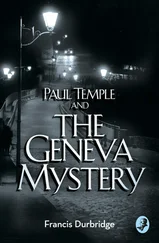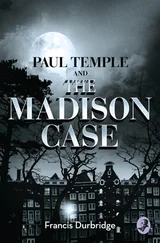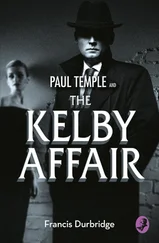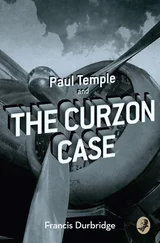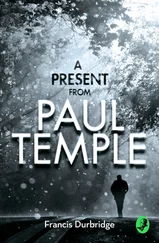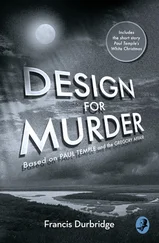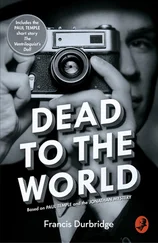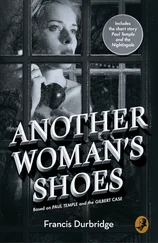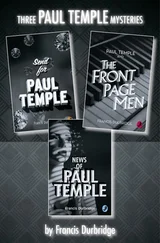FRANCIS DURBRIDGE
Back Room Girl
PLUS
Light-Fingers
AND
A Present from Paul Temple
WITH AN INTRODUCTION BY MELVYN BARNES


an imprint of HarperCollins Publishers Ltd
1 London Bridge Street
London SE1 9GF
www.harpercollins.co.uk
First published in Great Britain by John Long 1950
‘Light-Fingers’ and ‘A Present from Paul Temple’
first published in the Daily Mail Annual for Boys and Girls
by Associated Newspapers 1950, 1951
Copyright © Francis Durbridge 1950, 1951
Introduction © Melvyn Barnes 2018
Cover layout design © HarperCollins Publishers Ltd 2018
Francis Durbridge asserts the moral right to be identified as the author of this work.
A catalogue copy of this book is available from the British Library.
This novel is entirely a work of fiction. The names, characters and incidents portrayed in it are the work of the author’s imagination. Any resemblance to actual persons, living or dead, events or localities is entirely coincidental.
All rights reserved under International and Pan-American Copyright Conventions. By payment of the required fees, you have been granted the non-exclusive, non-transferable right to access and read the text of this e-book on screen. No part of this text may be reproduced, transmitted, down-loaded, decompiled, reverse engineered, or stored in or introduced into any information storage and retrieval system, in any form or by any means, whether electronic or mechanical, now known or hereinafter invented, without the express written permission of HarperCollins.
Source ISBN: 9780008242039
Ebook Edition © February 2018 ISBN: 9780008242022
Version: 2018-01-09
Table of Contents
Cover
Title Page
Copyright
Introduction
Chapter I: Strange Visitors
Chapter II: Discovery of no Man’s Cove
Chapter III: A Man’s Life
Chapter IV: Rude Awakening
Chapter V: Chief Inspector Leyland Explains
Chapter VI: Bait for a Trap
Chapter VII: Atomic Secrets
Chapter VIII: A Shot in the Dark
Chapter IX: Smugglers and Monks
Chapter X: The Man With the Handcart
Chapter XI: Attempted Murder
Chapter XII: Strange Behaviour at the Inn
Chapter XIII: Midnight Rendezvous
Chapter XIV: Coffee for Three
Chapter XV: The Man in the Combe
Chapter XVI: Charlie Gets a Shock
Chapter XVII: Two Casualties
Chapter XVIII: The Old Priory
Chapter XIX: Ordeal by Torture
Chapter XX: This Way Out
Chapter XXI: Council of War
Chapter XXII: The Bolt-Hole
Chapter XXIII: Through the Tunnel
Chapter XXIV: Trapped Again
Chapter XXV: No Exit?
Chapter XXVI: Curtain for Delouris
Light-Fingers
A Present From Paul Temple
Solution to: Light-Fingers
By the Same Author
About the Author
Also in This Series
About the Publisher
When Back Room Girl was published in July 1950, Francis Durbridge (1912–1998) had long been the most popular writer of mystery thrillers for BBC radio and was soon to become a ‘brand name’ on television and in the theatre. In 1938 the BBC had broadcast his serial Send for Paul Temple , and the novelist-detective and his wife Steve cemented their cult status in the sequels Paul Temple and the Front Page Men (1938), News of Paul Temple (1939), Paul Temple Intervenes (1942), Send for Paul Temple Again (1945) and many more. These first five radio serials were all novelised, published by John Long between 1938 and 1948, and most recently reissued in 2015 by Collins Crime Club.
Back Room Girl , however, was markedly different. It was Durbridge’s first book not to feature the Temples, and neither was it based on a radio serial. Instead it was an original one-off novel, which by the end of Durbridge’s writing career still compared only with The Pig-Tail Murder (1969) in this respect, although he had penned several standalone Sunday newspaper serials in the 1950s.
The Temple mysteries had invariably seen the sophisticated couple pursuing and unmasking murderers, so they all had a ‘whodunit?’ element. Back Room Girl , on the other hand, was not a detective mystery but an adventure/espionage thriller concerning skulduggery in a rural English setting. From the somewhat whimsical opening sentence, ‘It was early on the highly appropriate day of Friday that Roy Benton first saw the footprints in the sand,’ it must have been immediately obvious to any Paul Temple fan that this was not going to be typical Durbridge fare.
The year is 1947, and Fleet Street crime reporter and SAS hero Major Roy Benton begins a new life by retiring to No Man’s Cove in Cornwall to write his memoirs. He anticipates peace and quiet, but this seems increasingly unlikely when he discovers that a disused tin mine has become a research laboratory for a top secret project. He finds that the brilliant scientist Karen Silvers is heading the operation, and that his friend Chief Inspector Wilfred Leyland has been seconded from Scotland Yard because a sinister organisation is intent on stealing the plans.
The ringleader is Fabian Delouris, and he and his henchmen are Nazis (‘the worst Gestapo types’) who use extreme forms of torture to extract the information they require. ‘I have been,’ says Delouris, ‘a dealer in mass murder and the means to it for more years than I care to remember.’ This could account for the fact that Back Room Girl has not been translated and in particular has never been published in Germany, where Durbridge is otherwise a great favourite and where almost all of his novels have appeared.
The book has some themes that remain relevant today. For example, it speculates about the morality of Karen’s work on developing a weapon of mass destruction. ‘A curious way of preventing war,’ comments Roy, ‘to have a bigger stick than the other fellow, but … it’s the best we can do until we learn more sense’; whereas Karen believes that ‘This thing is so deadly, so devastating, that its very existence ought to prevent anyone ever going to war again.’ Underlying the story is also an element of surprise that a woman has been put in such a powerful position, although feisty Karen has always believed that ‘men had been merely people with whom she had to work because there weren’t enough women scientists.’
Back Room Girl therefore showed Durbridge in a new and unusual light, and he followed it up with two more novels that appeared to continue his move away from Paul Temple. But this was illusory, as Beware of Johnny Washington (April 1951) was a re-write of his first novel Send for Paul Temple , with some plot changes and a new set of characters without Paul and Steve, while Design for Murder (November 1951) was a novelisation of his 1946 radio serial Paul Temple and the Gregory Affair , but again with new characters instead of the Temples. (Both books, originally published by John Long and out of print for over sixty-five years, have now finally also been reissued.)
A key factor in Durbridge’s success as an entertainer, however, was his astuteness in recognising what his audience wanted. For the rest of his career as a novelist, apart from his standalone The Pig-Tail Murder , he concentrated on two reliable publishing categories. The first was the Paul Temple mysteries, which resumed in 1957 until 1988, of which five were based on his radio serials and three were original novels: The Tyler Mystery (1957), Paul Temple and the Harkdale Robbery and Paul Temple and the Kelby Affair (both 1970). The second category was adaptations of his phenomenally popular television serials, sixteen of which he novelised between 1958 and 1982. There were also two further instances of nifty recycling when Durbridge turned the radio serials Paul Temple and the Gilbert Case and Paul Temple and the Jonathan Mystery into the non-Temple novels Another Woman’s Shoes (1965) and Dead to the World (1967).
Читать дальше



